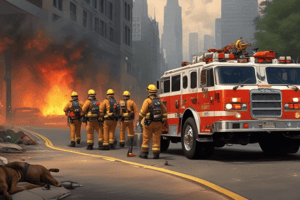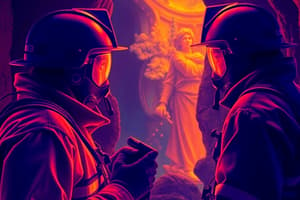Podcast
Questions and Answers
What is the primary purpose of the Two-In/Two-Out rule during an offensive fire attack?
What is the primary purpose of the Two-In/Two-Out rule during an offensive fire attack?
- To ensure all firefighters are trained in defensive operations.
- To establish a communication protocol for all firefighters.
- To maintain a minimum personnel safety requirement in IDLH situations. (correct)
- To allow firefighters to function without any backup.
Which equipment is NOT explicitly required for the Two-In firefighters entering an IDLH atmosphere?
Which equipment is NOT explicitly required for the Two-In firefighters entering an IDLH atmosphere?
- Self Contained Breathing Apparatus (SCBA)
- Forcible entry tools
- A thermal imaging camera (correct)
- Two-way portable radio
What action should be taken if fewer than four firefighters are available on scene before entering an IDLH atmosphere?
What action should be taken if fewer than four firefighters are available on scene before entering an IDLH atmosphere?
- Engage in defensive fire attack or other essential functions. (correct)
- Wait for additional firefighters to arrive before proceeding.
- Proceed with the offensive attack cautiously.
- Establish a temporary command center for coordination.
What responsibility does the Incident Commander have regarding the Two-Out firefighters?
What responsibility does the Incident Commander have regarding the Two-Out firefighters?
How many firefighters must be present on scene to initiate an offensive operation in an IDLH atmosphere?
How many firefighters must be present on scene to initiate an offensive operation in an IDLH atmosphere?
Which of the following is one of the conditions that must be checked before entering a structure on fire?
Which of the following is one of the conditions that must be checked before entering a structure on fire?
Which guideline must the Two-In firefighters follow regarding accountability in dangerous atmospheres?
Which guideline must the Two-In firefighters follow regarding accountability in dangerous atmospheres?
What must one of the Two-Out firefighters be capable of doing?
What must one of the Two-Out firefighters be capable of doing?
Flashcards
Offensive Fire Attack
Offensive Fire Attack
A fire attack strategy where firefighters enter a burning structure to extinguish the fire directly, often with a hose line.
IDLH Atmosphere
IDLH Atmosphere
An environment that is immediately dangerous to life and health due to factors like oxygen deficiency, toxic gases, or high heat.
Two In - Two Out Rule
Two In - Two Out Rule
The minimum number of firefighters required to safely perform an offensive fire attack in an IDLH environment. It ensures two firefighters are available inside for fire suppression while two remain outside for backup and safety.
Two In Firefighters
Two In Firefighters
Signup and view all the flashcards
Two Out Firefighters
Two Out Firefighters
Signup and view all the flashcards
Defensive Fire Attack
Defensive Fire Attack
Signup and view all the flashcards
360 Degree Size Up
360 Degree Size Up
Signup and view all the flashcards
Personal Accountability
Personal Accountability
Signup and view all the flashcards
Prior to initiating in Offensive (inside) Mode
Prior to initiating in Offensive (inside) Mode
Signup and view all the flashcards
Entering a structure involved with fire and having limited back up places firefighters
Entering a structure involved with fire and having limited back up places firefighters
Signup and view all the flashcards
Firefighters should only enter a structure after __ and having given consideration to the potential risk to personnel.
Firefighters should only enter a structure after __ and having given consideration to the potential risk to personnel.
Signup and view all the flashcards
The “Two-In” firefighters entering the IDLH atmosphere shall have:
The “Two-In” firefighters entering the IDLH atmosphere shall have:
Signup and view all the flashcards
The “Two-In” firefighters entering the IDLH atmosphere shall have:
The “Two-In” firefighters entering the IDLH atmosphere shall have:
Signup and view all the flashcards
If at least four firefighters are not on scene for a safe Offensive Mode of operation, then the firefighters shall perform other essential functions, such as:
If at least four firefighters are not on scene for a safe Offensive Mode of operation, then the firefighters shall perform other essential functions, such as:
Signup and view all the flashcards
The ____ shall assign at least two firefighters (“Two-Out”), in
appropriate PPE, for any “Two-In” firefighters that enter an IDLH atmosphere.
The ____ shall assign at least two firefighters (“Two-Out”), in appropriate PPE, for any “Two-In” firefighters that enter an IDLH atmosphere.
Signup and view all the flashcards
If a rescue profile exists upon arrival at an incident
If a rescue profile exists upon arrival at an incident
Signup and view all the flashcards
Any time the above “Two-In/Two-Out” exception is utilized, the firefighters must
Any time the above “Two-In/Two-Out” exception is utilized, the firefighters must
Signup and view all the flashcards
Study Notes
-
Purpose: Establish guidelines for sufficient personnel during offensive fire attack operations in potentially hazardous atmospheres.
-
Scope: Applies to all Emergency Operations personnel.
-
Offensive Fire Attack Operations:
-
Minimum Personnel: A minimum of four firefighters (two-in/two-out) required before entering an Immediately Dangerous to Life and Health (IDLH) atmosphere.
-
IDLH Applicability: The two-in/two-out rule applies during offensive operations in IDLH situations.
-
Two-In Firefighters:
- Pre-Entry: Conduct 360-degree size-up and assess personnel risk.
- Equipment: Full Personal Protective Equipment (PPE), Self-Contained Breathing Apparatus (SCBA), engaged PASS device, two-way portable radio, forcible entry tools, flashlight.
-
Alternative Actions (if insufficient personnel): Perform defensive fire attack, secure water supply, deploy hose lines, or approach the structure while maintaining control of openings.
-
-
Two-Out Firefighters:
- Assignment: Incident Commander assigns at least two firefighters to monitor and communicate with the inside firefighters.
- Monitoring: One Two-Out firefighter primary responsibility is monitoring and potentially communicating with the inside firefighters.
- Secondary Tasks: Another Two-Out firefighter may take on other essential tasks, as long as these tasks are easily abandoned without increasing risk to other personnel
-
Rescue:
- Exception: The Two-In/Two-Out rule does not prohibit rescue activities.
- Fewer Personnel: Fewer than four firefighters may enter if a rescue profile exists.
- Documentation: If the Two-In/Two-Out exception is used, document the action and justification using Incident Reporting.
Studying That Suits You
Use AI to generate personalized quizzes and flashcards to suit your learning preferences.




